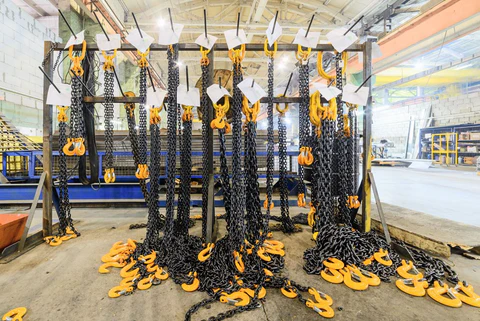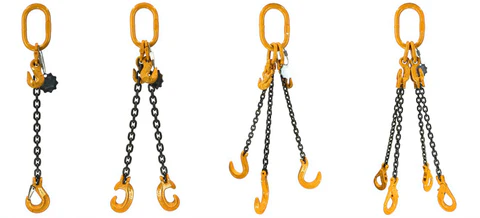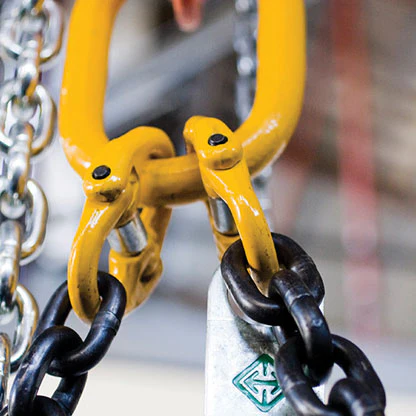The Ultimate Guide to Chain Slings
Chain slings are a vital component in lifting and rigging operations, providing a strong and dependable method for moving heavy loads. Whether you're working on a construction site, in a manufacturing plant, or during transportation, chain slings play a crucial role in ensuring both safety and efficiency. In this detailed guide, we’ll walk you through the fundamentals of chain slings, their importance in lifting tasks, how to choose the right one for your needs, best practices for use and handling, and essential maintenance and inspection tips.

Understanding Chain Slings: What They Are and How They Work
At their core, chain slings are made up of interlocked metal links, typically constructed from high-quality alloy steel. These chains are designed to handle significant weight and are known for their strength, durability, and resistance to wear. Over time, chain slings have evolved from simple iron chains used in ancient times to highly engineered systems that can withstand extreme conditions and heavy-duty applications.
One of the main benefits of using chain slings is their ability to conform to different load shapes, which helps maintain balance and stability during lifts. They’re also resistant to abrasion, heat, and cutting, making them ideal for environments where sharp edges or high temperatures are common. This versatility makes chain slings a popular choice across many industries.
Types of Chain Slings
There are several types of chain slings available, each suited for different lifting scenarios. The most common include single-leg, double-leg, triple-leg, and four-leg configurations. Single-leg slings are perfect for vertical lifts, while multi-leg slings provide better balance and control when lifting irregularly shaped or heavier objects.
Choosing the right type depends on factors like the weight of the load, the angle at which it will be lifted, and the environment in which the sling will be used. Each configuration offers unique advantages, so it’s important to understand your specific lifting needs before selecting a chain sling.

Why Chain Slings Matter in Lifting Operations
Chain slings are more than just tools—they are essential for maintaining safety and operational efficiency. Their robust design allows them to support heavy weights without compromising integrity, even under harsh conditions. In industries where precision and reliability are key, chain slings offer a proven solution for lifting and moving large, cumbersome items.
From construction sites to shipyards and industrial warehouses, chain slings are used daily to move equipment, machinery, and materials. Their ability to distribute weight evenly and resist damage makes them a preferred choice over other lifting methods in many cases.
Key Safety Considerations
Safety should always come first when using chain slings. Proper training, regular inspections, and adherence to manufacturer guidelines are essential to prevent accidents and equipment failure. Workers should be trained to recognize signs of wear, such as stretched links, cracks, or corrosion, and to replace damaged slings immediately.
Additionally, proper storage and maintenance—like lubrication and cleaning—are necessary to ensure long-term performance. Neglecting these steps can lead to premature wear and increase the risk of dangerous incidents during lifting operations.
How to Choose the Right Chain Sling for Your Job
Selecting the correct chain sling is critical to the success of any lifting operation. Factors like load weight, lifting angle, environmental conditions, and the shape of the object being lifted all influence the choice of sling. It's also important to consider the material of the load, especially if it has sharp edges that could damage the sling.
Consulting with an experienced professional or referring to manufacturer load charts can help you determine the appropriate capacity and configuration for your needs. Always ensure that the sling’s working load limit (WLL) matches or exceeds the weight of the load to avoid overloading and potential failure.
Proper Use and Handling of Chain Slings
Even the strongest chain sling won’t perform well if not used correctly. Following proper procedures ensures both the longevity of the equipment and the safety of workers. This includes securing the sling properly, avoiding sudden movements, and maintaining clear communication during lifts.
It’s also important to store chain slings in a dry, clean area when not in use. Exposure to moisture, chemicals, or extreme temperatures can degrade the material over time. Regular inspections and lubrication are recommended to keep the chain in good condition and ready for the next job.

Maintenance and Inspection of Chain Slings
Regular maintenance and inspection are essential to ensure chain slings remain safe and functional. Trained personnel should inspect the slings for signs of wear, such as elongated links, cracks, or deformation. Any damaged components must be replaced immediately to avoid failure during use.
In addition to visual checks, it’s important to monitor the condition of hooks, shackles, and other attachments. Keeping the chain clean and properly lubricated can significantly extend its lifespan and improve performance. A consistent maintenance schedule is a key part of responsible equipment management.
Conclusion
Chain slings are an indispensable tool in the world of lifting and rigging. Their strength, durability, and adaptability make them a go-to solution for a wide range of industries. By understanding how they work, choosing the right type for your needs, and following proper usage, handling, and maintenance procedures, you can ensure safer and more efficient lifting operations.
Whether you're a seasoned professional or new to the field, taking the time to learn about chain slings can make a big difference in your workflow and safety. With the right knowledge and care, chain slings can serve you reliably for years to come.
E-juice Nicotine Salt Kiwi Passion Fruit,Vape Us Nicotine Kiwi Passion Fruit,All Refillable Vape Available Oxva,E Cig E Liquid For Vape
Shenzhen Tianzhu Biotechnology Co., Ltd , https://www.yokaivape.com